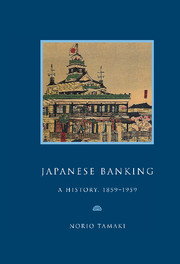Book contents
- Frontmatter
- Contents
- Preface
- Genealogy of leading Japanese banks, 1859–1959
- List of abbreviations
- Map
- Part I A bankrupt Shogunate, 1859–1868
- Part II The Meiji Restoration: monetary confusion and banking experiments, 1868–1881
- Historical background
- 5 The first banking experiment, 1868–1872
- 6 The national bank system: the American influence, 1870–1881
- 7 The origins of ordinary banking: another bank mania, 1875–1881
- 8 The search for stability: the last bank controversy, 1879–1881
- Part III Matsukata, the wizard of Japanese banking, 1881–1897; the Yokohama Specie Bank (1880) and the Bank of Japan (1882)
- Part IV The Japanese on the London money market, 1897–1911
- Part V War, the Japanese boom years, 1911–1919
- Part VI Crisis and the road to war, 1919–1937
- Part VII Complete commitment, struggle and defeat, 1937–1945
- Part VIII American ‘democratisation’ and the search for growth, 1945–1959
- An extraordinary century, 1859–1959
- Appendices
- Notes
- Bibliography
- Index
7 - The origins of ordinary banking: another bank mania, 1875–1881
Published online by Cambridge University Press: 03 February 2010
- Frontmatter
- Contents
- Preface
- Genealogy of leading Japanese banks, 1859–1959
- List of abbreviations
- Map
- Part I A bankrupt Shogunate, 1859–1868
- Part II The Meiji Restoration: monetary confusion and banking experiments, 1868–1881
- Historical background
- 5 The first banking experiment, 1868–1872
- 6 The national bank system: the American influence, 1870–1881
- 7 The origins of ordinary banking: another bank mania, 1875–1881
- 8 The search for stability: the last bank controversy, 1879–1881
- Part III Matsukata, the wizard of Japanese banking, 1881–1897; the Yokohama Specie Bank (1880) and the Bank of Japan (1882)
- Part IV The Japanese on the London money market, 1897–1911
- Part V War, the Japanese boom years, 1911–1919
- Part VI Crisis and the road to war, 1919–1937
- Part VII Complete commitment, struggle and defeat, 1937–1945
- Part VIII American ‘democratisation’ and the search for growth, 1945–1959
- An extraordinary century, 1859–1959
- Appendices
- Notes
- Bibliography
- Index
Summary
Private banking: adaptable ryogae, 1875–1881
The 1876 revisions of the National Bank Decree allowed would-be bankers to use the title ‘bank’, but it was only Mitsui who could immediately take this opportunity to establish themselves as a western-style modern bank. As was seen, Mitsui had earlier in 1872 planned to set up their own bank but were persuaded to support the government scheme of bringing about the national bank system. In addition to this earlier willingness, there was another reason for Mitsui to make efforts to renew their proposal.
When it was established, the First National Bank was accommodated in premises specially built by Mitsui for their own banking purposes. As has already been explained,1 Mitsui had unwillingly joined the house of Ono in launching the First National Bank. When at the end of 1874 the house of Ono collapsed, Mitsui considered its position. Mitsui wrote to Shibusawa, chief auditor of the First Bank, detailing fifteen complaints including their shareholdings, use of Mitsui premises as the First Bank offices and withdrawal of bank clerks who had been Mitsui employees. Shibusawa, who was intending to take over the management of the Bank, remained unmoved, rejecting most of the complaints and concluding:
As far as the institution [First Bank] has been established carrying ‘the bank’ as its title, I think that the issue department [for the Ministry of Finance] would not ignore the fact that Mitsui Gumi have treated the Bank as their branch shop. As the situation might be considered to cause certain inconveniences, the Bank should, I think, be put in a position free from such shortcomings when the revisions of the National Bank Decree would be made.
- Type
- Chapter
- Information
- Japanese BankingA History, 1859–1959, pp. 40 - 45Publisher: Cambridge University PressPrint publication year: 1995

